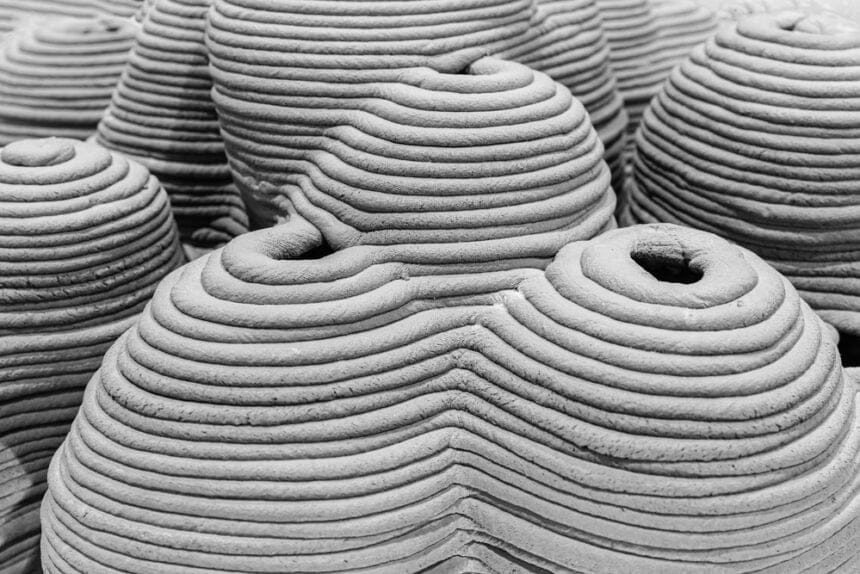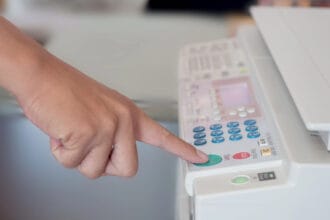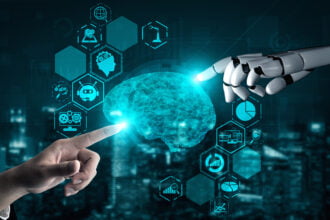3D-printed concrete is a revolutionary technology that has been making waves in the construction industry over the last few years. Artificial intelligence has made 3D-printing even more effective. Kishor K talked about the benefits of Generative AI for 3D printing, but we wanted to talk in more detail specifically about 3D-printed concrete.
AI-driven 3D-printing is a process that involves using sophisticated machine learning algorithms to facilitate the printing of concrete structures layer by layer with a 3D printer, making it possible to create intricate details with high accuracy and precision. This technology is transforming the construction sector, making it possible to build faster, cheaper, and more sustainable buildings. Global companies spent over $17 billion on 3D-printing last year and new advances in AI should cause that market to grow even further.
As the world becomes more technologically advanced, 3D printing has emerged as a groundbreaking innovation with limitless possibilities. However, the process of creating intricate designs and models can be time-consuming and complex. This is where AI comes in, revolutionizing the world of 3D printing by providing invaluable assistance and streamlining the entire process.
AI technology has proven to be an indispensable tool for designers and engineers in the realm of 3D printing, including those creating concrete structures. By harnessing the power of artificial intelligence, professionals can now optimize their workflow, enhance precision, and unlock new levels of creativity.
This article will explore 3D-printed concrete, including its advantages, challenges, and potential applications with AI technology. We will also discuss the current state of the technology and what the future may hold for 3D-printed concrete. So, if you are curious about this innovative technology and what it could mean for the future of construction, read on to learn everything you need to know about 3D-printed concrete.
Before we delve into the benefits of using AI for these purposes, we want to provide an overview of 3D-printed concrete in general.
What is 3D Printed Concrete?
It is a 3D printing process that uses a mixture of special concrete and a binding agent to create a three-dimensional model. This model can then be used to construct buildings, bridges, and other structures.
3D-printed concrete is a relatively new technology that is still being developed and improved. It is a form of additive manufacturing, which means that the materials used to create the structure are added layer by layer. This process allows for more precise and intricate designs than traditional construction methods.
Advantages of 3D Printed Concrete:
3D printing of concrete has numerous benefits that make it one of the most sought-after construction techniques in the industry.
1. Cost Savings: One of the most significant advantages of 3D-printed concrete is its cost-efficiency. 3D printing machines require minimal setup and can produce complex shapes with ease. The cost of raw materials used in 3D printing is also relatively low compared to traditional construction methods. This makes 3D-printed concrete an attractive alternative for those who plan to build cost-effective structures.
2. Time Savings: 3D concrete printing is faster than traditional methods. This is because the process does not require molding or cutting of materials. Instead, the 3D printer can print the desired shape with just a few clicks. This eliminates the need for manual labor, which can save time and money.
3. Design Flexibility: 3D printing of concrete also offers a great degree of design flexibility. The 3D printer can be programmed to create any number of shapes, sizes, and textures. This makes it possible to create structures that are customized to the customer’s specifications. This is especially beneficial for architects who want to create unique layouts for their clients.
4. Durability: 3D-printed concrete is also highly durable. The structures created by 3D printers can withstand extreme temperatures and weather conditions. This means that they are not only aesthetically pleasing but also long-lasting.
5. Eco-Friendly: 3D printing of concrete is also a much eco-friendlier option than traditional methods. This is because the process does not require any hazardous chemicals or materials. This reduces the amount of waste created during the construction process, which helps to protect the environment.
Disadvantages of 3D Printed Concrete:
1. Cost: 3D printing with concrete is relatively expensive compared to traditional construction methods. This is due to the costs of the materials, the printer itself, and the technical expertise required for operation.
2. Limited Design Options: 3D printing with concrete can only print in fairly simple shapes due to the limitations of the printer.
3. Limited Materials: Currently, only concrete can be printed with 3D printing, so there are limited options for the material used in the construction.
4. Durability: The printing process itself can create weak points in the structure, as the printer is moving in a single direction and leaving behind layers of concrete that may not be as strong as a monolithic structure.
5. Time: 3D printing with concrete is a slow process, so the construction process takes much longer than traditional methods.
6. Environmental Impact: 3D printing with concrete produces a large amount of waste, as large amounts of concrete are used in the printing process, which can harm the environment.
Application of 3D Printed Concrete:
3D-printed concrete can be used to construct complex building elements that were previously impossible to create with traditional construction technologies. These elements include curved walls, arches, and other shapes that can be printed directly from a computer model.
3D-printed concrete can also be used to create lightweight structural elements that are strong enough to support large loads. This technology can be used to create complex architectural designs that are both aesthetically pleasing and structurally sound.
3D-printed concrete is also used to create customized precast components such as staircases, columns, and beams. 3D printing makes it possible to produce parts with complex shapes and sizes that are impossible with traditional construction methods.
3D-printed concrete can also be used to create custom-made elements for interior design. This technology allows designers to create unique, intricate patterns and shapes that would normally be too difficult or expensive to produce using traditional methods.
Best Concrete 3D Printers:
1. KODAK Portrait 3D Printer
The KODAK Portrait 3D Printer is a great choice for printing concrete 3D models. This printer uses a unique printing process that allows for precise layer-by-layer construction of the model, resulting in very accurate results. It features a large build area, a heated build plate, and a user-friendly interface. The Portrait 3D Printer supports a variety of materials, including concrete, plastic, and metal.
2. Builder Extreme 1500 Pro
The Builder Extreme 1500 Pro is excellent for 3D printing concrete models. This printer features a large build area, a heated build plate, and automated calibration. It is also compatible with a variety of materials, including concrete, plastic, and metal. Its open-source software allows users to customize the printing process for their specific project.
3. BigRep Pro
The BigRep Pro is a professional 3D printer designed for printing large concrete models. It features a large build area, a heated build plate, and automated calibration. The printer supports various materials, including concrete, plastic, and metal. With its open-source software, users can customize the printing process for their specific project.
4. XYZPrinting da Vinci Pro
The XYZPrinting da Vinci Pro is suitable for printing concrete models. This printer features a large build area, a heated build plate, and automated calibration. It is compatible with a variety of materials, including concrete, plastic, and metal. With its open-source software, users can customize the printing process for their specific project.
5. Airwolf 3D AXIOM
The Airwolf 3D AXIOM is a professional 3D printer designed for printing large concrete models. This printer features a large build area, a heated build plate, and automated calibration. It is also compatible with a variety of materials, including concrete, plastic, and metal. Its open-source software allows users to customize the printing process for their specific project.
3D Printed Concrete with the help of SelfCAD:
3D printed concrete is a revolutionary technology that enables the production of complex concrete structures in a fraction of the time it would typically take. This process is made easier with SelfCAD, a powerful 3D modeling and printing platform. The intuitive user interface and automated tools of this software allow users to quickly create 3D models of their desired structures, which can then be 3D printed using reinforced concrete.
SelfCAD’s online slicer also enables users to customize the thickness, layers, and other printing parameters of the concrete being used, thereby allowing for maximum customization and efficiency. Furthermore, the3D printing simulation feature of SelfCAD will enable users to preview and adjust their structures before they are printed. This feature allows users to optimize their print time, thus ensuring they get the most out of their 3D printer.
Finally, SelfCAD’s compatibility with various 3D printers and materials, including reinforced concrete, makes it the perfect tool for 3D printing concrete structures.
Transforming construction, one layer at a time!
3D-printed concrete is a safe and reliable way to build without compromising design or quality. It is an effective way to reduce labor costs, waste, and time. 3D printing technology in the construction industry has made it easier for architects and engineers to create complex designs and structures. With the advancement of 3D printing technology, 3D-printed concrete can be used for various applications, from homes and buildings to bridges and tunnels. 3D-printed concrete is a viable and sustainable solution for the construction industry. It provides an efficient and cost-effective way to build structures while reducing waste and labor costs.
What Are the Benefits of Using AI for 3D-Printing Concrete
One of the key advantages that AI brings to 3D printing is its ability to generate complex designs with remarkable efficiency. With AI algorithms analyzing vast amounts of data and patterns, designers can easily create intricate structures that were once considered impossible or incredibly time-consuming.
Furthermore, AI can assist in automating various aspects of the 3D printing process. From selecting suitable materials to optimizing print settings for maximum efficiency, AI algorithms ensure that every step is executed flawlessly. This not only saves valuable time but also minimizes errors and reduces material wastage.
Additionally, AI-powered software can simulate various scenarios before actual production takes place. By running virtual tests and simulations, designers can identify potential flaws or weaknesses in their designs without having to physically print them first. This not only saves resources but also enables them to iterate quickly and improve their designs before final production.
The role of AI in 3D printing goes beyond just enhancing design capabilities; it also enables collaboration among different stakeholders involved in the process. With cloud-based platforms powered by AI technology, designers from around the world can collaborate seamlessly on projects regardless of their physical location. This fosters a global community where knowledge sharing and innovation thrive.
AI Helps with Creating 3D-Printed Concrete Structures
In conclusion, AI has become an indispensable ally for professionals involved in 3D printing, including those creating concrete structures. Its ability to generate complex designs efficiently, automate processes, simulate scenarios, and facilitate collaboration has revolutionized the industry. As technology continues to advance, the role of AI in 3D printing will undoubtedly grow, opening up new possibilities and pushing the boundaries of what can be achieved in this exciting field.











